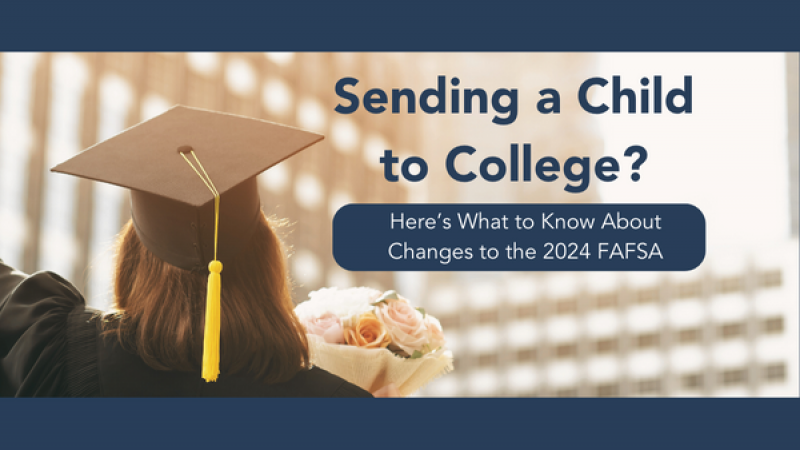Sending a Child to College? Here’s What to Know About Changes to the 2024 FAFSA

If you are preparing to send your child off to college within the next year, you may find yourself filling out the Free Application for Federal Student Aid (FAFSA) to find out if and how much financial aid he or she is entitled to as a higher education student. Whether you have completed the FAFSA before or are thinking of starting the process for the first time, there are notable changes to the process and timeline of the 2024 application that you should be aware of. Here are answers to questions you may have about the FAFSA.
What is the FAFSA?
It’s the application you must complete to qualify to receive federal financial assistance for higher education. The FAFSA form collects financial information about a student and their family to determine eligibility for financial aid. In 2024, the questionnaire process is simplified because required federal tax information can be imported directly from the IRS. The forms to apply can be found at www.StudentAid.gov.
Does it make sense for me to complete the FAFSA process?
If your child wants access to federal loans or grants for the 2024-2025 school year, they need to complete a FAFSA application. It is important to note that all students should apply regardless of their family’s financial status, as some form of federal financial aid is available to most. The student also may be considered for merit-based scholarships or on-campus jobs.
If your child has never applied, they must create a Federal Student Aid ID to start the process. Also, all parents or spouses who will be contributors to the FAFSA application must create their own account. In the event you don’t have online access, you can call 1-800-433-3243 to receive a printed form.
What information do I need to complete FAFSA?
Be sure to have:
The student’s information, such as date of birth, Social Security number, address and contact information.
Social Security numbers for the student’s parents or spouse.
Other identifying information such as driver’s license number (if you have one) or Alien Registration for non-U.S. citizens.
Tax return information for family members involved in the process (spouse, parents).
Information on cash, savings, and checking account balances.
Net worth information on investments, businesses, and properties.
The name of the college or career school your student is attending. If he or she is still in high school, you can list up to 20 schools that they are considering.
What happens after I complete the form?
Within three to five days of completing the online application (seven to ten days for a paper application), you’ll receive a copy of the Student Aid Report that summarizes your student’s information. Check it for accuracy and make corrections if needed. This will provide a summary of your Expected Family Contribution, which determines eligibility for a Federal Pell Grant. Ultimately, the information is passed on to the schools you listed in your FAFSA form.
What is the deadline to file for the 2024-25 school year?
Given the late release of the application this year due to the changes made, the window to complete the FAFSA form has been reduced. First, check with the colleges to which your student has applied, as they often have different deadlines. If seeking state aid, check on their filing deadlines as well. The ultimate federal filing deadline is usually June 30, but if colleges or your state have an earlier deadline, that takes precedence.
Preparing to send a loved one to college can be an exciting but stressful time, both financially and personally. A financial advisor can help answer questions you may have as you navigate the milestones of preparing for higher education.
Publisher’s Note: The Veritas Scholars Academy Diploma Program aims to educate seniors during their college application process. Completing the FAFSA (Free Application for Federal Student Aid) might be helpful, but only relates to a student once they are accepted into college and is not associated with VSA. By filing the FAFSA, new and returning students college students can access a variety of funding sources for college, such as grants, federal work-study, and loans. Some colleges also require a FAFSA on file for merit scholarships, but not all colleges require it. For more information about the FASFA, go to the official website.
About the Author
Cristina Gabalda, CFP®, is a Financial Advisor with Ameriprise Financial Services, LLC. in Alexandria, Virginia. She specializes in fee-based financial planning and asset management strategies and has been in practice for 25 years. To contact her, visit Cristina Gabalda, Financial Advisor in Alexandria, VA (ameripriseadvisors.com), or call 703-981-0327. Office address: 5680 King Centre Drive, Suite 600, Alexandria VA 22315.
Financial Planner Board of Standards, Inc. (CFP Board) owns the CFP® certification mark, the CERTIFIED FINANCIAL PLANNER™ certification mark, and the CFP® certification mark (with plaque design) logo in the United States, which it authorizes use of by individuals who successfully complete CFP Board’s initial and ongoing certification requirements.
Investment products are not insured by the FDIC, NCUA or any federal agency, are not deposits or obligations of, or guaranteed by any financial institution, and involve investment risks including possible loss of principal and fluctuation in value.
Securities offered by Ameriprise Financial Services, LLC. Member FINRA and SIPC.
© 2023 Ameriprise Financial, Inc. All rights reserved.







